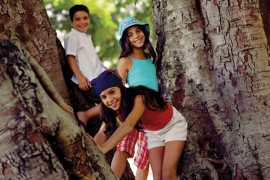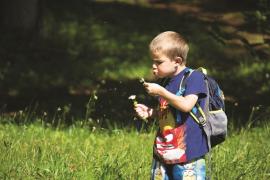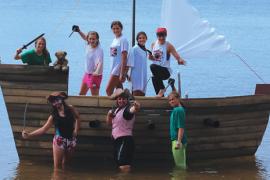When I was four, I fell in love with Hot Wheels toy cars. My favorite was a drag racer with its own parachute. The chute clipped to the underside of the car with a pair of wire hooks. You packed the chute in a tiny compartment behind the back wheels and it deployed when a knob on the track clicked the compartment open. It was really cool.
I noticed one day that the wire hooks resembled an electrical plug. And so I did the logical thing for a four-year-old: I inserted those hooks into an outlet. Pop! The thin wires vaporized in a flash, turning my fingers black and red. I must have yelped, but I don’t remember that part. I do remember my mother calling from the kitchen. “What was that? Chris? Are you all right?” By the time I heard her footsteps running down the hall, I had already dashed into the bathroom to scrub the discoloration from my wounded extremity. But burns don’t wash off.
When four-year-olds are interrogated by their concerned parents about the origins of a smoldering outlet, they probably shouldn’t whimper and hide their hands behind their backs. That’s the behavioral equivalent of a neon sign that says, “I’ve messed up big time and I’m wounded.”
Hot Wheels stopped making clip-on metal parachutes for its drag racers in 1974. Probably because of kids like me. Now that I’m forty-four, I’ve discovered that everyone was a kid like me . . . at some point.
A Brief History of Dumb Stuff
Kids have always done dumb stuff. They’ve broken bones climbing trees without harnesses; bloodied themselves riding skateboards without pads; stood in pools of water while plugging in appliances; tested the relative explosive power of kerosene versus gasoline; stuck certain small toy parts in certain bodily orifices; eaten the remaining small toy parts out of simple curiosity; and — when they are a bit older — experimented with the performance limits of their parents’ vehicles and their own genitals and the ways in which those performance limits are affected by various drugs.
Of course, young people don’t have a corner on the stupidity market. It’s just that when adults do dumb stuff and the results lead to discoveries, we call it genius. In 1752, Ben Franklin, on a quest to prove that lightning was a massive form of static electricity, flew a kite into a storm cloud and then accidentally touched the metal key inside the Leyden jar (a primitive capacitor) he was holding. Owie. In the 1890s, Marie Curie exposed herself to more gamma radiation than it took Bruce Banner to transform into The Incredible Hulk. Her exposure eventually killed her and her daughter/collaborator, Irene Curie, but not before Curie became the first woman to win the Nobel Prize, in 1911.
Not all dumb stuff is harmful or fatal; some is happenstance. And if it’s not genius, it’s at least ingenious. For example, 3M’s Art Fry borrowed his co-worker Dr. Spencer Silver’s 1968 recipe for a low-tack reusable adhesive using some scrap yellow paper from the lab next door. Voila! Post-it Notes. Fry had originally used the sticky scrap as a bookmark in his hymnal. Now both the Post-it name and the yellow color are patented. Not dumb stuff, perhaps, but a lucrative accident to say the least.
When adult recklessness lacks scientific or commercial merit, we simply bestow them with a “Darwin Award” or roll our eyes. When Evel Knieval attempted to jump the Snake River Canyon in a steam-powered rocket and (surprise) failed, the rest of the human population was neither shocked nor smarter. We all just smirked and quipped, “What did you expect?” Knieval detractors ate a bit of humble pie in 1999 when Evel’s son, Robbie, jumped a 230-foot gap in the Grand Canyon on a motorcycle and lived. In the Knieval tradition, Robbie’s early jump attempts ended in broken bones, concussions, and comas, calling into question my thesis that dumb stuff actually teaches. I suppose that every theory has exceptions, even if the laws of physics do not.
Accidents and Learning
Kids do most dumb things without a clear vision of the consequences. My six-year-old once picked up a pneumatic nail gun, aimed it at his face and pulled the trigger. (Fortunately, nail guns don’t fire unless the tip is depressed. And in this case — thank goodness — it wasn’t even pressurized or loaded.) But even if they have a vague idea of what might happen, young people’s impulsive behaviors are never intended for scientific or commercial merit. Kids are simply — and quite naturally — curious. (What does the business end of a nail gun look like, anyway?)
Curiosity, it is said, killed the cat. Or, more specifically, curiosity killed a cat, but not all the cats. Occasionally and tragically, irresponsible behaviors lead to injury, disability, or death. According to the Centers for Disease Control (2012), the leading cause of death among U.S. residents ages one to thirty-four is unintentional injuries. Some of those are related to criminal violence, but the vast majority of deaths are what we would call accidents (motor vehicle mishaps, falls, bumps, cuts, burns, poisoning, and drowning). What we don’t have statistics on are nonlethal, “I-did-a-dumb-thing” injuries. But because we survive them, we can learn from them. Doing dumb stuff teaches something. Our job as youth leaders is to ensure that those lessons last.
Perhaps the oldest teaching tool is a camp favorite: fire. Since people discovered how to make fire (probably around 400,000 years ago, give or take 100,000 years) they have sat around these fires and conveyed their experiences. Initially, this was done with gestures, urgently conveying the need for more wood, perhaps.
Modern humans developed language about 100,000 years ago, give or take 50,000 years. Therefore, no one knows when the first real campfire story was. It’s my guess that — in a wonderfully circular irony — the first campfire stories were about campfires themselves. Or, more specifically, the first stories were about injuries sustained and sidestepped on the path toward reliable fire building. (My son’s first word was “hot,” the evolutionary significance of which has not been lost on me.)
Since that first campfire story, which probably began with “Well, we never thought the whole forest would burn down” and ended with “Don’t touch that white stuff. It’s still really hot,” adults have been recounting their experiences to their peers and their progeny. Oral traditions are humanity’s oldest cultural glue. They are our personhood, our group membership, our values, and our collective intelligence. They are the plots of our literature, the subjects of our artwork, and the storylines of our performances. Contemporary campfires take many forms, including, in increasing pithiness: live theater and dance, feature films, television programs, YouTube, Twitter, and graffiti. Everyone has a story. And the most interesting ones involve, well, doing dumb stuff.
To Lecture or Let Learn?
During my summers as a cabin leader at Camp Belknap, I took great pride in not needlessly calling upon the maintenance staff. One day, a light bulb blew and I climbed up on a rafter to change it out. I tossed the spent bulb down to one of my campers, Rusty, and got to work screwing in the new bulb. Rusty’s silence suggested to me that he was watching intently, so I began a comparative lecture on incandescent versus fluorescent light.
When I swung down from the rafter, I discovered that Rusty’s silence had nothing to do with watching me change a light bulb or listening to my luminescent lecture. The fear in his eyes and silence from his throat came from his having stretched his jaw open to its absolute maximum and inserting the 100-watt glass orb into his mouth. His teeth and lips had then closed gently around the stem of the bulb. Having suddenly (but nevertheless later) realized that a mouthful of glass shards was a likely unintended consequence, he tried to widen his mouth back to its insertion size. Alas, his jaw muscle had tired enough from not clamping down that he couldn’t quite widen his teeth around the fattest part of the bulb. He had not yet succumbed to closing his mouth, but panic had set in. I could see it was a matter of time before we had a case for the next periodontal textbook.
It took two other leaders to extract the bulb: one to verbally calm Rusty down and another to help me gently pry his jaw open. When I pulled the slobbery bulb out intact, we all breathed a sigh of relief. And we had an answer to the new joke “How many camp counselors does it take to change a light bulb?” Answer: two. One to screw in the new light bulb and another to make sure no campers try to swallow the old one.
At that point, I was at a classic care¬giver crossroads: to punish and lecture or to teach. The most tempting question for me — for any adult in the face of such absurdity — was: “What were you thinking?” We all know now that the neurologically honest answer is: “I wasn’t. I couldn’t. My frontal lobes are notably underdeveloped.”
Any lecture about putting glass in one’s mouth would have been as inane as asking, “What were you thinking?” And so I chose to sit down next to Rusty and just take a deep breath. I suppose that my silence implied the question about lessons learned because after a while he said, “That was really dumb. If that bulb had broken in my mouth, it would have really hurt. Good luck explaining that to my parents in a letter. Like, ‘Hey, camp is great but I have a mouth full of stitches because I broke a light bulb in my mouth . . . by accident.’”
He put his head in his hands. “What was I thinking?” he asked. I smiled. That was twenty-five years ago and I’m willing to bet that Rusty has always thought twice before putting any nonfood object in his mouth. Lesson learned.
Fascination and Frontloading
We are fascinated by others’ dumb behavior, as the popularity of America’s Funniest Home Videos and movies such as Jackass prove. Mistakes — even others’ mistakes — put us in touch with our common humanity. To wit, Michael Phelps has won more Olympic medals than any athlete in history. And yet there are more YouTube views of stories discussing Phelps’ having been caught on camera smoking marijuana than of news stories covering his record-breaking fifteenth gold medal. We also find virtuosity and competition intriguing, of course. The pot shots and medal ceremonies together have millions fewer views than the video of Phelps out-touching Milorad Cavic in the 100-meter butterfly by 0.1 second at the 2008 Olympics.
As Cavic might contend, humans can no more easily engineer certain victory than certain failure. Therefore, any adult hope for exerting absolute control over young people’s learning is futile. Yet we are not helpless. In our work with youth, we can maximize chances for learning by participating in the post-experience discussion. Or, as my light bulb experience with Rusty taught me, by showing young people compassion and companionship while they figure out what happened and what comes next.
Too often, adults frontload educational experiences, spending hours designing lessons and holding children’s hands as they step through our mature learning scripts. Instead, we should spend more time getting out of young people’s way, letting them enjoy unstructured free play, and checking in with them when it wraps up. Sadly, our camps have become less unique and more like every other experience for young people: overstructured and overscheduled.
The Death of Learning
Authors like Wendy Mogul and Richard Louv have indirectly argued for camps’ original mission by advocating for experiential learning and outdoor recreation. It is now time to extend their arguments by recognizing how safety and biology collide. The collision between adult protectiveness and youth brain development creates a learning graveyard.
Adult protectiveness focuses on two things: safety and outcomes. We want to protect children from physical and emotional injury and we want to design curricula intentionally, in order to achieve certain goals. Taken separately, safety and outcomes are noble goals. Taken together, they can conflict and undermine meaningful education. Simply put, there are times when we outthink ourselves. Consider, for example, the new rule at my son’s elemen¬tary school: No red playground
balls on the playground.
Yes, you read that correctly. No playground balls on the playground, at least in the morning. And there’s more. As children gather on the playground each morning before the 8:25 bell, they are also not allowed to be on the grass or to run. No doubt the administration devised these rules because of noble safety concerns. Some child must have been hit in the face by an errant ball; another slipped and got wet on the dewy grass of the sports field; and another two children collided on the blacktop because they weren’t looking where they were running.
Curiously, this is the same school where — like every other school — the classrooms and hallways have colorful posters reinforcing the values of sports¬manship, cooperation, peaceful conflict resolution, and sharing. Here, too, we find evidence of noble goals: to intentionally teach character values in order to achieve the outcomes of less bullying and friendlier behavior.
Yet notice the result of over engineering children’s learning. Instead of trained teachers participating in the many post-experience discussions that would happen on an active playground, this school has transformed their playground into a hygienic parking lot, leaving the students little real-world context for the posters they are reading inside.
Deficiency by Design?
Nobody wants children to get hurt, so reasonable safety parameters must be in place. But let’s not forget that vivid and emotional experiences create lasting memories — the very essence of learning. Is it possible that young people’s under-developed brains (especially those pesky frontal lobes used for impulse control and hypothetical reasoning) are not deficient at all but evolutionarily advantageous? Doesn’t some impulsivity, naiveté, and recklessness permit youth to take the risks that become the most powerful learning experiences of their lives?
Although adults cannot ethically en¬gineer treacherous experiences for youth, we can certainly participate in their post-mistake narratives. Unlike the classic outdoor education debrief of an experience designed by adults, these post-mistake narratives are essentially debriefs of experiences thoughtlessly, impulsively, and spontaneously performed by young people.
We all screwed up when we were young, so let’s avoid the temptation to punish and lecture when our own children (or those we take care of) screw up. Yes, there are consequences for egregious misbehaviors. But a dismissive or shameful approach to garden-variety mistakes suggests that those mistakes were developmentally abnormal and that there was no value in the experience. Both suggestions are patently false.
There is no need to glorify recklessness as you share your own experiences, but young people do benefit from the occasional war story. Just be sure that when you talk with a young person about the dumb stuff you have done, you don’t engage in one-upmanship. (“You think that’s bad, let me tell you about a time when I was your age.”) Avoid the temptation to recast a young person’s experience. Simply listen to how they lived it.
It’s Simple Biology
Kids do dumb stuff. It’s built into their brains. It’s simple biology. And no amount of safety measures can stop something that is evolutionarily advantageous. However, safety measures can retard learning when taken to an extreme. There is a three-way balance between protecting children, engineering outcomes, and allowing learning to happen. We can only achieve that balance when we recognize the value of dumb stuff.
So, when kids do something asinine, sigh quickly. Then welcome the lessons attached to that experience. You can express concern, even anger. You can even punish from time to time. But let your dominant approach to young people’s development be to embrace the hidden treasure of dumb stuff.
Reference
Centers for Disease Control. (2012). Injuries and violence are leading causes of death: Key data & statistics. Retrieved from www.cdc.gov/injury/overview/data.html
Christopher Thurber, PhD, ABPP, is a psychologist, author, and instructor at Phillips Exeter Academy. He is the cofounder of ExpertOnlineTraining.com and the host of ACA’s homesickness prevention DVD. Dr. Thurber presents at camps, schools, and conferences around the world. Contact him through his Web site, www.CampSpirit.com.
Originally published in the 2013 January/February Camping Magazine



